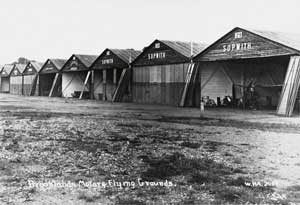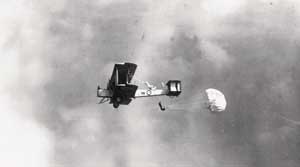|
In 1917, the British Air Board issued a specification for a multi-engine, three-seat night bomber that could carry 3,000 pounds of bombs and bomb gear over a range of 300 miles at an altitude of 6,000 feet and at a speed of 80 to 85 miles per hour. At Vickers, the team responsible for designing a plane to meet this specification was led by Rex Pierson. Pierson, who had started at Vickers in 1908 as an engineering pupil-apprentice, was only 26 in 1917 when he was appointed chief designer of the Vickers Aircraft Division.
Vickers assigned its design the number F.B.27. The first F.B.27 flew only three and a half months after the contract was placed, a considerable feat even for a large company. Powered by two 200-horsepower Hispano-Suiza V8 engines and spanning 68 feet, the F.B.27 prototype made its maiden flight on November 30, 1917. Succeeding prototypes differed in various details but were destroyed in crashes. The company was not deterred, and in March 1918 the name “Vimy” was given to the F.B.27. The system then in use required that a three-seat bomber built by Vickers be named after a French town beginning with U or V.
 |
|
| Vickers Limited established a facility at Brooklands, “cradle of British aviation”, where the Vimy was built. Courtesy of Philip Jarrett. |
|
| |
|
Eleven Vimy Squadrons were to be deployed with the Independent Air Force of the Royal Air Force (RAF) starting in May 1919, but the Armistice of November 1918 put an end to these plans. Many Vimy contracts, for a total of more than 1,000 aircraft, were severely curtailed or canceled. Limited production continued, however, and some 235 production Vimys were built. The first were not delivered until February 1919.
In July 1919, the Vimy finally entered service. The first Vimys went to Egypt, where they were a mainstay of the RAF activities in the Middle East, serving as both bombers and transports. From late 1921 through early 1926, Vimys began flying the demanding 860-mile route delivering mail between Cairo, Egypt, and Baghdad, Iraq. Vimys were also used for other nonmilitary purposes throughout the 1920s. During the General Strike of 1926 in the UK, for instance, they distributed newspapers.
Vimy as Trailblazer
In 1919 and 1920, the Vimy won undying fame. John Alcock and Arthur Whitten Brown’s nonstop transatlantic flight on June 14—15, 1919, in a converted Vimy heralded an age of intercontinental and transcontinental long-distance flying. A Vimy was the chosen mount of Ross and Keith Smith for their epic flight from England to Australia in November 1919, and of Pierre van Ryneveld and Christopher Quintin Brand for their troubled flight to the Cape in 1920.
Shortly after Alcock and Brown’s flight, a drawing was prepared for a Vimy converted for commercial use. The design, which called for passengers to be seated in open cockpits, remained unbuilt. Instead, Vickers created the Vimy Commercial, one of the first purpose-designed airliners. The pilot and copilot were still unprotected in the open cockpit, but the 10 passengers were enclosed in the fuselage and had windows on the outside world. In the rear fuselage and beneath the cockpit were 300 cubic feet of luggage space. The most famous Vimy Commercial was the City of London, which flew between Croydon, Paris, Brussels, and Cologne. By April 1924, it had logged 107,950 miles.
 |
|
| One of the Vimy’s last duties in the RAF was for training parachutists. Courtesy of Philip Jarrett. |
|
| |
|
Other designs were developed from the Vimy, including the Vernon troop carrier, which had room for 11 troops and three crew. Some traces of the original Vimy were retained in the Victoria troop carrier. It had a much longer monocoque fuselage married to the wings of the Virginia bomber, the Vimy’s successor. In its initial form, the Virginia’s structural design was based on that of the Vimy. The Victoria was then re-engined to become the Valentia. When the airframe was also replaced, in the mid-1930s, the last Vimy components disappeared.
|
|
|
 |